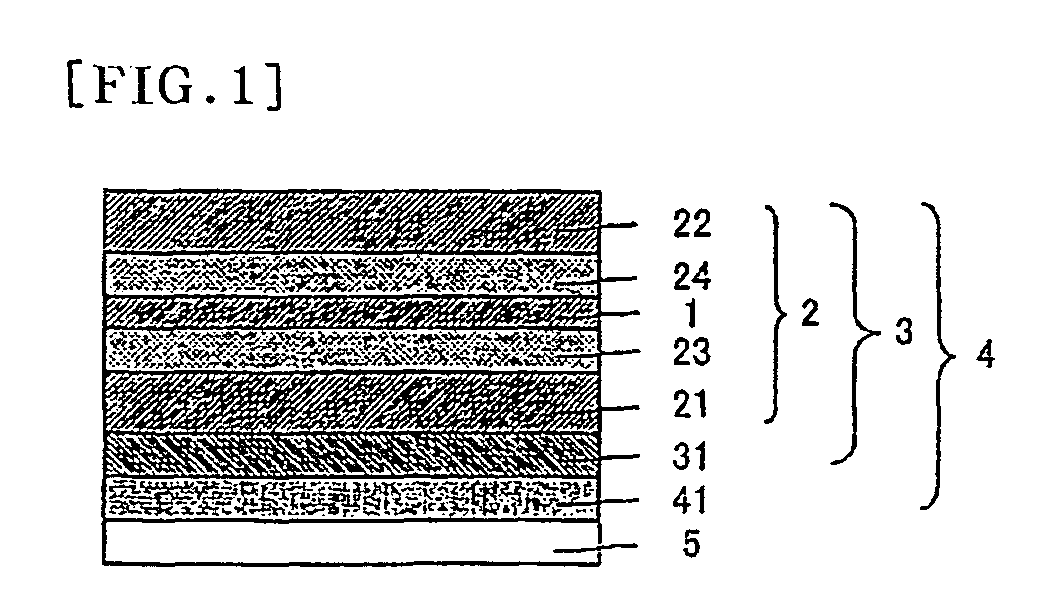Pressure-sensitive adhesive and retardation layer-attached polarizing plate, method for manufacturing thereof, optical film, and image display
a technology of pressure-sensitive adhesive and retardation layer, which is applied in the direction of polarizing elements, paper/cardboard containers, instruments, etc., can solve the problems of poor adhesion of pressure-sensitive adhesive layers with good stress relaxation properties, significantly reduced visibility, and general poor adhesion of pressure-sensitive adhesive layers. , to achieve the effect of resisting discoloration, preventing discoloration, and maintaining visibility
- Summary
- Abstract
- Description
- Claims
- Application Information
AI Technical Summary
Benefits of technology
Problems solved by technology
Method used
Image
Examples
example 1
[0190]A 75 μm-thick polyvinyl alcohol film with an average polymerization degree of 2400 and a saponification degree of 99.9% by mole was immersed in warm water at 30° C. for 60 seconds and allowed to swell. The film was then immersed in an aqueous iodine solution with an iodine / potassium iodide (1 / 7 in weight ratio) concentration of 0.4% and dyed while it was stretched such that the stretch ratio reached 3.5 times. The film was then stretched in an aqueous boric acid ester solution at 65° C. such that the total stretch ratio reached 6 times. The film was further immersed in an aqueous solution of 3% potassium iodide at 30° C. for 5 seconds. After stretching, the film was dried in an oven at 40° C. for 3 minutes to give a polarizer. The polarizer had a single-piece transmittance of 42.4%.
(Transparent Protective Film)
[0191]An 80 μm-thick triacetylcellulose film was used.
(Retardation Layer-Attached Transparent Protective Film)
[0192]Wide View Film SA manufactured by Fuji Photo...
example 2
[0197]A polarizer was obtained using the process of Example 1, except that the concentration of the aqueous iodine solution was changed to 0.37% so that the single-piece transmittance of the resulting polarizer was changed to 43.2%.
[0198]A retardation layer-attached polarizing plate and then a pressure-sensitive adhesive and retardation layer-attached polarizing plate were prepared using the process of Example 1, except that the polarizer prepared as described above was used instead. The retardation layer-attached polarizing plate had a dimensional shrinkage of 0.40%.
example 3
Preparation of Pressure-Sensitive Adhesive
[0199]To a four-neck flask equipped with a nitrogen introducing tube and a cooling tube were added 95 parts of butyl acrylate, 5 parts of acrylic acid, 0.1 parts of 2-hydroxyethyl acrylate, 0.05 parts of 2,2-azobisisobutyronitrile, and 200 parts of ethyl acetate. After sufficient replacement with nitrogen, the mixture was subjected to polymerization reaction at 55° C. for 20 hours with stirring under a stream of nitrogen gas so that an acrylic polymer with a weight average molecular weight of 1,570,000 was obtained. An acrylic pressure-sensitive adhesive was obtained by uniformly mixing a solution of the acrylic polymer relative to 100 parts of a solid matter, 0.08 parts of 3-glycidoxypropyltrimethoxysilane, and 0.8 parts of a polyisocyanate crosslinking agent composed of a tolylene diisocyanate adduct of trimethylolpropane.
(Preparation of Pressure-Sensitive Adhesive and Retardation Layer-Attached Polarizing Plate)
[0200]The pressure-sensitiv...
PUM
| Property | Measurement | Unit |
|---|---|---|
| temperature | aaaaa | aaaaa |
| dimensional shrinkage | aaaaa | aaaaa |
| transmittance | aaaaa | aaaaa |
Abstract
Description
Claims
Application Information
 Login to View More
Login to View More - R&D
- Intellectual Property
- Life Sciences
- Materials
- Tech Scout
- Unparalleled Data Quality
- Higher Quality Content
- 60% Fewer Hallucinations
Browse by: Latest US Patents, China's latest patents, Technical Efficacy Thesaurus, Application Domain, Technology Topic, Popular Technical Reports.
© 2025 PatSnap. All rights reserved.Legal|Privacy policy|Modern Slavery Act Transparency Statement|Sitemap|About US| Contact US: help@patsnap.com


